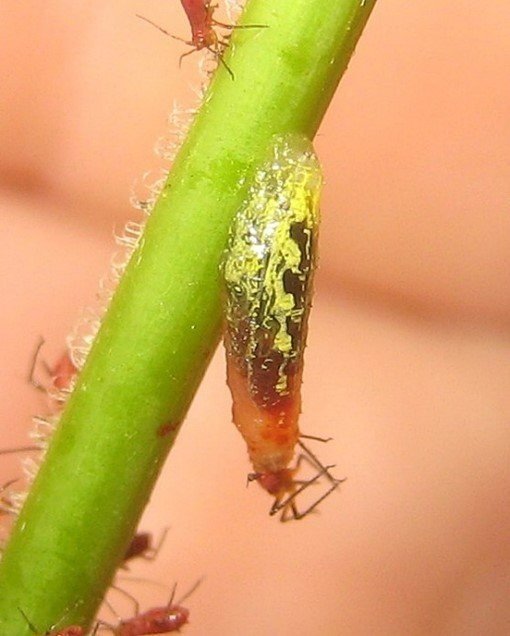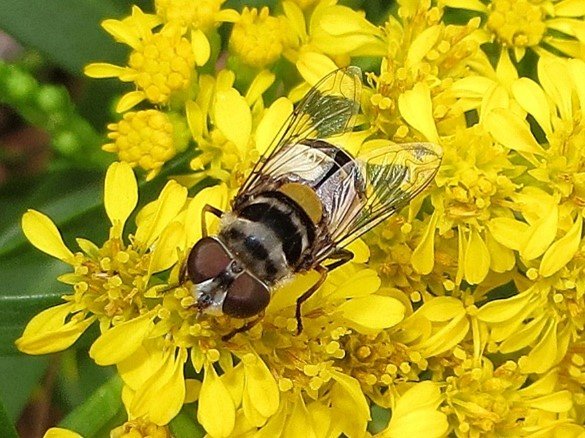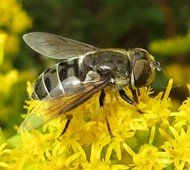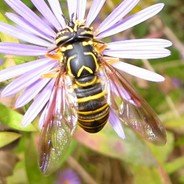Audubon at Home Sanctuary Species
Hover Flies (Syrphidae)
Meromacrus acutus - Carolinian Elegant. Photo by Judy Gallagher
Eristalis transversa - Transverse-banded Flower Fly. Photo by Cliff Fairweather
Hover Flies, also called flower or drone flies, form a large family of true flies (order Diptera) that visit flowers for nectar and pollen. In addition to providing pollination services, many hover fly larvae help with pest control. Their larvae eat aphids – up to over a thousand in a lifetime – and can reduce aphid populations by 70% or more! Hover flies are attractive insects with bright, bold patterns and colors. They are also fascinating to watch as they fly about the garden, often hovering in mid-air.
Identification: Many hover flies are remarkable bee or wasp mimics, with bold yellow or white and black stripes. This Batesian mimicry is intended to fool predators by making hover flies look like something dangerous. But don’t worry, they don’t bite or sting. Like all true flies, they have only one pair of wings and, like most other true flies, they have short antennae that emerge close together at the front of the head, between their large eyes. Bees and wasps have two pairs of wings, and their antennae are more widely separated and longer. Hover flies range in size from about 1/8 – 1 inch and are often seen hovering near flowers. The larvae are slug-like, with tapered, yellow, green, or brown bodies, often with white or yellow markings.
Range: Hover flies are found throughout our region.
Breeding: Mating and egg-laying occur during the growing season. Species with aphid-feeding larvae lay eggs on plants near aphid colonies and their pupae develop on leaf surfaces. Other species lay eggs on or near food sources, such as decaying vegetation.
| What Hoverflies Need | How Can We Help |
|---|---|
| Food and Water: The adults of most common garden species feed on nectar and pollen. The larvae of many species eat large numbers of aphids, along with thrips, small caterpillars, and other soft-bodied, plant-feeding insects. Some larvae are aquatic and feed on detritus suspended in water, and others feed on decayed vegetation or rotting wood. |
|
| Shelter: Hover flies shelter in a variety of situations, depending on species and life stage. Some species overwinter as adults in sheltered places such as under loose tree bark. Pupae shelter on leaves or overwinter in leaf litter. Some larvae are aquatic, living in shallow, oxygen poor water. These rat-tailed maggots breathe air through a long tail-like tube that reaches the surface. Others live in decaying vegetation, tree rot holes, or nests of ants, termites, or bees. |
|
| Breeding: Adults of aphid-eating species lay eggs on plants near aphid colonies. Others lay eggs on or near their larval food sources. |
|
| Other:This is a large and diverse family with diverse lifestyles, so they benefit from varied habitat. |
|
Resources: Bugguide: Family Syrphidae - Hover Flies https://bugguide.net/node/view/196; Ohio's Natural Enemies: Hover Flies https://ohioline.osu.edu/factsheet/ent-73
Where to See Model Habitat and Observation Sites: Long Branch Nature Center Native Plant Garden, Arlington, VA https://www.arlingtonva.us/Government/Departments/Parks-Recreation/Locations/Nature-Centers/Long-Branch-Nature-Center






